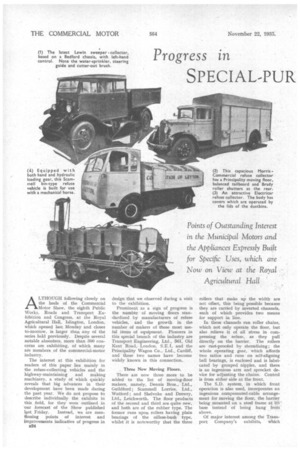Progress in
Page 34

If you've noticed an error in this article please click here to report it so we can fix it.
SPECIAL-PUR
Points of Outstanding Interest in the Municipal Motors and the Appliances Expressly Built for Specific Uses, which are Now on View at the Royal
Agricultural Hall
ALTHOUGH following closely on the heels of the Commercial Motor Show, the eighth Public Works, Roads and Transport Exhibition and Congress, at the Royal Agricultural Hall, Islington, London, which opened last Monday and closes to-morrow, is larger than any of the series held previously. Despite several notable absentees, more than :100 concerns are exhibiting, of which many are members of the commercial-motor industry.
The interest at this exhibition for readers of this paper lies mainly in the refuse-collecting vehicles and the highway-maintaining and making machinery, a study of which quickly reveals that big advances in their development have been made during the past year. We do not propose to describe individually the exhibits in this field, for they were outlined in our forecast of the Show published
last, Friday. Instead, we are mentioning points of interest and improvements indicative of progress in i324
design that we observed during a visit to the exhibition.
Prominent as a sign of progress is the number of moving floors standardized by manufacturers of refuse vehicles, and the growth in the number of makers of these most useful items of equipment. Pioneers in this special branch of the industry are Transport Engineering, Ltd., 561, Old Kent Road, London, S.E.1, and the Principality Wagon Co., Ltd., Cardiff, and these two names have become widely known in this connection.
Three New Moving Floors.
There are now three more to be added to the list of moving-floor makers, namely, Dennis Bros., Ltd., Guildford; Scammell Lorries, Ltd., Watford; and Shelvoke and Drewry, Ltd., Letchworth. The floor products of the second and third are quite new, and both are of the rubber type. The former runs upon rollers having plain bearings of the oilless-bush type, whilst it is noteworthy that the three rollers that make up the width are not offset, this being possible because they are carried by inverted channels, each of which provides two means for support in line.
In these channels run roller chains, which not only operate the floor, but also relieve it of all 'stress in compressing the refuse, as they pull directly on the barrier. The rollers are rust-proofed by sheradizing; the whole operating gear, which affords two ratios and runs on self-aligning ball bearings, is enclosed and is lubricated by grouped nipples, and there is an ingenious arm and sprocket device for adjusting the chains. Control is from either side at the front.
The S.D. system, .in which front operation is also used, incorporates an ingenious compensated-cable arrangement for moving the floor, the barrier being mounted on a steel frame at 1..A base instead of being hung front above.
Of major interest among the Transport Company's exhibits, which




















































































